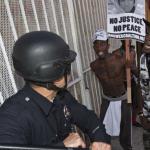From Michael Brown to Assata Shakur, the Racist State of America Persists

Although racist state violence has been a consistent theme in the history of people of African descent in North America, it has become especially noteworthy during the administration of the first African-American president, whose very election was widely interpreted as heralding the advent of a new, postracial era.
The sheer persistence of police killings of black youth contradicts the assumption that these are isolated aberrations. Trayvon Martin in Florida and Michael Brown in Ferguson, Missouri, are only the most widely known of the countless numbers of black people killed by police or vigilantes during the Obama administration. And they, in turn, represent an unbroken stream of racist violence, both official and extra-legal, from slave patrols and the Ku Klux Klan, to contemporary profiling practices and present-day vigilantes.
More than three decades ago Assata Shakur was granted political asylum by Cuba, where she has since lived, studied and worked as a productive member of society. Assata was falsely charged on numerous occasions in the United States during the early 1970s and vilified by the media. It represented her in sexist terms as “the mother hen” of the Black Liberation Army, which in turn was portrayed as a group with insatiably violent proclivities. Placed on the FBI’s Ten Most Wanted list, she was charged with armed robbery, bank robbery, kidnap, murder, and attempted murder of a policeman. Although she faced 10 separate legal proceedings, and had already been pronounced guilty by the media, all except one of these trials – the case resulting from her capture – concluded in acquittal, hung jury, or dismissal. Under highly questionable circumstances, she was finally convicted of being an accomplice to the murder of a New Jersey state trooper.
Four decades after the original campaign against her, the FBI decided to demonise her once more. Last year, on the 40th anniversary of the New Jersey turnpike shoot-out during which state trooper Werner Foerster was killed, Assata was ceremoniously added to the FBI’s Ten Most Wanted Terrorist list. To many, this move by the FBI was bizarre and incomprehensible, leading to the obvious question: what interest would the FBI have in designating a 66-year-old black woman, who has lived quietly in Cuba for the last three and a half decades, as one of the most dangerous terrorists in the world – sharing space on the list with individuals whose alleged actions have provoked military assaults on Iraq, Afghanistan and Syria?
A partial – perhaps even determining – answer to this question may be discovered in the broadening of the reach of the definition of “terror”, spatially as well as temporally. Following the apartheid South African government’s designation of Nelson Mandela and the African National Congress as “terrorists”, the term was abundantly applied to US black liberation activists during the late 1960s and early 70s.
President Nixon’s law and order rhetoric entailed the labelling of groups such as the Black Panther party as terrorist, and I myself was similarly identified. But it was not until George W Bush proclaimed a global war on terror in the aftermath of 11 September 2001 that terrorists came to represent the universal enemy of western “democracy”. To retroactively implicate Assata Shakur in a putative contemporary terrorist conspiracy is also to bring those who have inherited her legacy, and who identify with continued struggles against racism and capitalism, under the canopy of “terrorist violence”. Moreover, the historical anti-communism directed at Cuba, where Assata lives, has been dangerously articulated with anti-terrorism. The case of the Cuban 5 is a prime example of this.
This use of the war on terror as a broad designation of the project of 21st-century western democracy has served as a justification of anti-Muslim racism; it has further legitimised the Israeli occupation of Palestine; it has redefined the repression of immigrants; and has indirectly led to the militarisation of local police departments throughout the country. Police departments – including on college and university campuses – have acquired military surplus from the wars in Iraq and Afghanistan through the Department of Defense Excess Property Program. Thus, in response to the recent police killing of Michael Brown, demonstrators challenging racist police violence were confronted by police officers dressed in camouflage uniforms, armed with military weapons, and driving armoured vehicles.
The global response to the police killing of a black teenager in a small midwestern town suggests a growing consciousness regarding the persistence of US racism at a time when it is supposed to be on the decline. Assata’s legacy represents a mandate to broaden and deepen anti-racist struggles. In her autobiography published this year, evoking the black radical tradition of struggle, she asks us to “Carry it on. / Pass it down to the children. /Pass it down. Carry it on … / To Freedom!”
• Angela Davis is Distinguished Professor Emerita, history of consciousness and feminist studies, at the University of California, Santa Cruz. She wrote the foreword for Assata: An Autobiography
